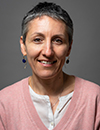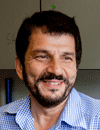Co-Located Conference AgendasInnovations in Flow Cytometry & Extracellular Vesicles 2024 | Lab-on-a-Chip and Microfluidics World Congress 2024 | Organoids, Spheroids & Organs-on-Chips 2024 | 

Monday, 18 November 202409:00 | Microfluidics and Nanofluidics for Diagnostic Tests Pre-Conference Training Course
Steve Soper, Foundation Distinguished Professor, Director, Center of BioModular Multi-Scale System for Precision Medicine, The University of Kansas, United States of America
Pre-Conference Training Course from 09:00-11:00 Venue: Slate Room
[Separate Registration Required to Attend this Pre-Conference Training Course]
| 11:00 | Pre-Conference Training Course from 11:00-13:00 Microfluidic Product Development [Separate Registration Required to Attend this Pre-Conference Training Course]
Leanna Levine, Founder & CEO, ALine, Inc., United States of America
This training course will explore the translation of science and nascent engineering programs into a well-structured product development program to address Reduction to Practice or proof of concept; Human factors engineering – what is it and why it matters; Design Control and Risk Control Roadmap for Development; Design for Manufacture and Assembly; Scale -up progression and manufacturing methods.
**A Must-Attend for Companies Embarking on Microfluidic Product Development** | |
Main Conference Registration, Materials Pick-Up and Networking in the Exhibit Hall |
| | |
Venue: Conference Entrance and Exhibit Hall |
| | 13:30 | Lab-on-a-Chip and Microfluidics World Congress 2024: Opening Plenary Session | 13:45 | Welcome and Introduction by the Chairs: Professor Dino Di Carlo and Dr. Leanna Levine, 2024 Conference Focus and Themes Highlighted Over the 3-Day Event | |
Venue: Plenary Ballroom |
| | 14:00 |  | Plenary Presentation Organ-on-Chip Systems to Probe Extracellular Vesicle Transport Across Biological Barriers
Steven C. George, Edward Teller Distinguished Professor and Chair, Department of Biomedical Engineering, University of California-Davis, United States of America
Extracellular vesicles (EVs) are small (50-150 nm diameter) composite particles secreted by cells and comprised of a lipid-based membrane surrounding an aqueous core. The membrane and core can each incorporate a wide range of molecules (e.g., proteins, nucleic acids) that can impact cellular function; thus, EVs can impact in vivo biology, but have also generated significant excitement for their potential theranostic (therapeutic and diagnostic) applications in cancer. How EVs are transported (convection, diffusion, and binding) across biological barriers including the vascular endothelium and extracellular matrix is poorly understood. Our early work demonstrates that a subpopulation of EVs are transported across the endothelium using receptor-mediated transcytosis, and predominantly by convection (not diffusion) through the extracellular space. During transport through the ECM, the EVs can bind (and unbind) to form a spatial gradient which may have biological implications for cell migration and tumor progression. Examination of EV transport across biological barriers will not only enhance our understanding of the dynamic tumor microenvironment, but also provide the framework to design artificial nanovesicles as novel drug delivery vehicles. |
| 14:30 |  | Plenary Presentation Microfluidic Immunoengineering
Abraham Lee, Chancellor’s Professor, Biomedical Engineering & Director, Center for Advanced Design & Manufacturing of Integrated Microfluidics, University of California-Irvine, United States of America
The COVID-19 pandemic, and the subsequent successful development of the mRNA vaccine has ushered in an era of immunoengineering. Immunoengineering involves the “reprogramming” of the immune system to overcome limitations of the innate or adaptive immune responses that the body naturally produces. Recent developments of microfluidics for precision medicine applications such as liquid biopsy, cell therapy, single cell analysis, and microphysiological systems have contributed to the general field of immunoengineering. Specifically, adoptive cell therapy (ACT) is a type of immunotherapy that involves the processing of blood from a donor to isolate immune cells (e.g. T cells) for genetic manipulation followed by reinfusion of the cells into patients. This process that starts from blood drawn from one person and ends with specialized engineered cells delivered to the patient includes multiple tedious and costly steps, and can require a long time that the patient may not have. Microfluidic technologies can address most steps of this complex cell manufacturing process, including cell harvesting, cell isolation, cell activation and expansion, and cell transfection. In this talk I will introduce two microfluidic platforms in my lab applied to the cellular engineering processes, one is the lateral cavity acoustic transducer (LCAT) and the other is droplet microfluidics. Based on LCAT, we developed the acoustic electric shear orbiting poration (AESOP) device to uniformly deliver genetic cargos into a large population of cells simultaneously. We demonstrate high quality transfected cells with controlled dosage delivery as well as serial delivery of different genetic cargos. These capabilities can be used to optimize the therapeutic efficacy of the engineered cells and also combine it with promising gene editing tools to further condition the cells for more specific in vivo targeting. Based on droplet microfluidics we constructed bottom-up artificial antigen presenting cells (aAPCs) for antigen-specific T cell activation. By trapping single cells in microfluidic droplet compartments, we are able to study the 3D cell morphology of both the cell surface and also its intracellular constituents to further understand immune cell activation and immune cell synapses. |
| 15:00 |  | Plenary Presentation Title to be Confirmed.
Valérie Taly, CNRS Research Director, Professor and Group leader Translational Research and Microfluidics, Université Paris Cité, France
|
| 15:30 | Mid-Afternoon Coffee Break and Networking in the Exhibit Hall | 16:15 |  | Plenary Presentation Brain Neurovascular Models and Their Application to Modeling Transport in Health and Disease
Roger Kamm, Cecil and Ida Green Distinguished Professor of Biological and Mechanical Engineering, Massachusetts Institute of Technology (MIT), United States of America
Despite recent FDA approval of two drugs to reduce amyloid beta (A-beta) plaque in Alzheimer’s patients, a true cure of the disease remains elusive since they simply reduce the rate of cognitive decline. Also, there is a need for deeper understanding of drug and toxin transport across the blood-brain barrier (BBB), which is difficult to obtain from animal experiments or human testing. To meet this need, a variety of in vitro microphysiological models have been developed that can accurately recapitulate the barrier properties of the brain vasculature in the context of A-beta clearance from, and toxin or drug entry into, brain tissues. This talk will focus on a progression of models developed to mimic both the healthy and diseased brain and to predict transport properties. Cells used in these models can be either primary or iPS cell-derived with the latter being increasingly used to produce standardized models with greater consistency over time and appropriate for screening by pharma and biotech companies. |
| 16:45 |  | Plenary Presentation New Technologies for Accelerating Progress in Cancer Immunotherapies
Jim Heath, President, Institute for Systems Biology, United States of America
|
| 17:15 |  | Plenary Presentation Integrating Innovations for the Advancement of Single Cell Analysis
Eric Diebold, WW Vice President, Research and Development, BD Biosciences, United States of America
2024 represents the 50th anniversary of the first commercial cell
sorter, commercialized by BD Biosciences. In this presentation, I will
cover some of the key innovations in flow cytometry over this period,
and discuss some of the more recent innovations in our industry that are
catapulting high parameter single cell analysis into the future. |
| 17:45 |  | Plenary Presentation Title to be Confirmed.
David Weitz, Mallinckrodt Professor of Physics and Applied Physics, Director of the Materials Research Science and Engineering Center, Harvard University, United States of America
|
| 18:15 | Patient Advocate for Cancer and Technology Development -- Patient Advocate Speaker Details to be Announced | 18:45 | Networking Reception in the Exhibit Hall with Beer, Wine and Dinner. Network with Colleagues, Engage with the Exhibitors and View Posters | 20:15 | Close of Day 1 of the Main Conference | 20:30 | 3D-Printing of Microfluidics Training Course Presented by Professor Noah Malmstadt
Noah Malmstadt, Professor, Mork Family Dept. of Chemical Engineering & Materials Science, University of Southern California, United States of America
Training Course held from 20:30-22:30
Venue: Slate Room
[Separate Registration Required to Attend this Training Course]
|
Tuesday, 19 November 202407:30 | Morning Coffee, Continental Breakfast and Networking in the Exhibit Hall | |
Session Title: Emerging Themes and Trends in Lab-on-a-Chip and Microfluidics 2024 |
| | |
Venue: Ballroom A |
| | 09:00 |  | Conference Chair Accelerating Life Science Research: From Lab-on-a-Chip to Lab-on-a-Particle
Dino Di Carlo, Armond and Elena Hairapetian Chair in Engineering and Medicine, Professor and Vice Chair of Bioengineering, University of California-Los Angeles, United States of America
Building on the successes of Lab on a Chip technologies, a new frontier is emerging in the form of Lab on a Particle (LoP) platforms. These innovative technologies complement traditional microfluidic systems by utilizing microparticles to confine samples and facilitate microscale reactions. Unlike the static nature of microfluidic chips, LoP platforms offer dynamic and flexible solutions where microparticles act as discrete, suspendable compartments capable of performing highly parallelized assays. This advancement significantly enhances the ability to analyze molecules and cells with higher throughput, while incorporating sophisticated assays. The microparticles used in LoP assays are meticulously engineered with unique shapes and chemistries, providing functionalities that were previously unattainable with conventional microfluidic chips. These particles can template droplets, capture specific molecules, cells, and secretions, or even barcode reactions for multiplexed analysis. The integration of essential assay materials and structures directly into each particle eliminates the dependency on custom chips or specialized instrumentation. As a result, LoP platforms are compatible with standard laboratory instruments such as flow cytometers, fluorescence activated cell sorters (FACS), microscopes, and other imaging devices. This compatibility positions LoP technologies akin to software applications, or apps, operating on commonly available life science instrument hardware. This analogy highlights the transformative potential of LoP platforms in democratizing access to advanced assay capabilities. By circumventing the need for specialized equipment, these microparticle-based systems can accelerate adoption and broaden the impact of microfluidic innovations across diverse research fields. In this keynote presentation, we will explore some recent Lab on a Chip innovations developed in our lab, including Ferrobotics, and introduce recent Lab on a Particle platforms and applications. We will discuss demonstrated applications, such as in antibody discovery, elucidating links between cell secretions and gene expression, and identifying therapeutically optimal cells, ultimately highlighting the future prospects of LoP technologies in accelerating all life sciences. |
| 09:30 |  | Keynote Presentation High-Throughput Mapping of Functional Proteins and Pathways
Adam Abate, Professor of Bioengineering and Therapeutic Sciences, University of California-San Francisco, United States of America
Despite advances in AI for predicting protein structures from sequences, predicting function remains challenging due to the dynamic nature of protein mechanics. High-throughput experimentation is a powerful method to study proteins, allowing the generation of empirically-based functional maps. However, this process requires analyzing hundreds of thousands of variants to thoroughly scan the mutational landscape for even a single protein. This talk will discuss methods for high-throughput characterization of functional proteins and pathways, including enzymes, membrane transporters, and antibodies. High-throughput sequence-function mapping will enable the generation of empirical datasets necessary for building accurate computational models of proteins and pathways and, ultimately, enabling the in silico design of proteins with new functions. |
| 10:00 |  | Keynote Presentation Title to be Confirmed.
Steve Soper, Foundation Distinguished Professor, Director, Center of BioModular Multi-Scale System for Precision Medicine, The University of Kansas, United States of America
|
| 10:30 | Mid-Morning Coffee Break and Networking in the Exhibit Hall -- Meet Exhibitors and View Posters | 11:00 | View Second Hall of Morning Session in the Organoids Track Agenda | 12:30 | Networking Buffet Luncheon -- Network with Exhibitors and Colleagues, View Posters | 13:20 | View Organoids and Organs-on-Chips Session from 13:30-15:00 in the Organoids Track Agenda | 15:00 | Mid-Afternoon Coffee Break and Networking in the Exhibit Hall | |
Session Title: 3D-Printing of Microfluidics |
| | |
Venue: Ballroom A |
| | 15:30 |  | Keynote Presentation Pushing Boundaries: High Resolution 3D Printing for Microfluidics
Gregory Nordin, Professor, Brigham Young University, United States of America
Interest in 3D printing for microfluidic device fabrication is high, but routinely achieving sub-100 µm features remains a challenge. This is because microfluidic devices primarily consist of negative space features, which require different considerations compared to positive space features common in other 3D printing applications. To address this, we have developed our own stereolithographic 3D printers and materials tailored to these requirements to explore what is possible with 3D printing for high resolution microfluidics. Our approach can create channels as small as 2 µm x 2 µm. We have also developed active elements, such as valves and pumps, with the smallest valves having an active area of just 15 µm x 15 µm. With these capabilities, we have demonstrated highly integrated 3D printed microfluidic components, such as a 10-stage 2-fold serial dilutor within a 2.2 mm x 1.1 mm footprint. Additionally, we have created a fast (~1 ms) and compact (<1 mm^3) 3D printed mixer using a new multi-resolution 3D printing method. These advancements position 3D printing as an attractive alternative to costly cleanroom fabrication processes. They offer the added benefit of fast (~5-15 minute), parallel fabrication of multiple devices in a single print run due to their small size, facilitating a path to mass manufacturing. |
| 16:00 |  A Platform For Commercialization of 3D Printed Microfluidics Embedded into Standard Well Plates A Platform For Commercialization of 3D Printed Microfluidics Embedded into Standard Well Plates
Jeff Schultz, Co-Founder, Phase, Inc.
Phase is developing an additive manufacturing process, termed 3D PDMS, to 3D print microfluidic devices using conventional thermally curable PDMS. To enable academic and industrial adoption of these advanced microfluidic devices, Phase is developing their VivorrayTM plate systems, which are sterilizable 96- and 384-well plates made from a USP Class VI certified material, that integrates 3D PDMS MF devices into well plates with industry standard geometries for automated high-throughput workflows. The resulting system will be a single fully automated microfluidic manufacturing platform with the design freedom of 3D printing capable of manufacturing complex PDMS microfluidic devices.
| 16:30 | Addressing Key Challenges in Multi-Material and Multi-scale Digital Projection Stereolithography
Pranav Soman, Professor, Biomedical and Chemical Engineering; IPA Program Director, Advanced Manufacturing (AM), National Science Foundation (NSF), Syracuse University, United States of America
This presentation will include two research projects conducted at Syracuse University and few outreach slides related to opportunities at NSF for the Additive Manufacturing community. First project, entitled, Multi-material Gradient Printing Using Meniscus-enabled Projection Stereolithography (MAPS) addresses current challenges related to vat based multi-material printing associated with hardware modifications, control systems, cross-contamination, waste, and resin properties. MAPS is a vat-free method that relies on generating and maintaining a resin meniscus between a cross-linked structure and bottom window to print lateral, vertical, discrete, or gradient multi-material 3D structures with no waste and user-defined mixing between layers. We show that MAPS can print 3D structures with gradient properties in mechanical stiffness, opacity, surface energy, cell densities, and magnetic properties. Second project, entitled Multipath projection stereolithography (MPS) addresses the inherent tradeoffs between print resolution, design complexity, and built sizes. Inspired by microscopes that could switch objectives to achieve multi-scale imaging, we report a new optical printer coined as MPS specifically designed for printing microfluidic devices. MPS is designed to switch between high- and low-resolution optical paths to generate centimeter sized constructs (3cm x 6cm) with a feature resolution of ~10µm. Using a test-case of micromixers, we show user-defined CAD models can be directly input to an automated slicing software to define printing of low-resolution features with embedded micro-scale fins. A new computational model, validated using experimental results, was used to simulate various fin designs and experiments were conducted to verify simulated mixing efficiencies. | 17:00 |  ASIGA Advancing 3D Printed Microfluidics ASIGA Advancing 3D Printed Microfluidics
Bryce Hiller, Digital Education Coordinator, ASIGA
ASIGA is a leader in reliable and precise DLP 3D Printers. In this talk we will show you how to leverage our open material system and voxel-level control over all parameters in our 3D printers to create cutting edge Microfluidic Chips.
| 17:30 |  Microfluidics and Mask-Aligner: How to Make the Right Choice? Microfluidics and Mask-Aligner: How to Make the Right Choice?
Nicolas Brillouet, CTO, Kloé
Mask-aligners have been used for decades as key technological equipments to manufacture microchips, in particular in semiconductor industry. More recently, these equipments, historically based on the use of mercury lamps as the UV-source, have also been considered as relevant systems to enable the fabrication of chips in microfluidics (molds / PDMS casting, Lab On a Chip, Organ on A Chip…) in particular thanks to the cost effective use of plastic/flexible photomasks (before considering the use of chrome photomasks to achieve higher resolution). However, the use of mercury lamps, that was already very energy consuming, is also now worldwidely compromised in a very near future by considering the global ban of using mercury in fluorescent lighting (Minamata Convention on Mercury) that entered into force in 2017, and that has been ratified by 140 countries, while the last use exemptions remain presently in effect later by 2027. Without waiting for this recent decision dedicated to protect human health and the environment from the adverse effects of mercury, our company KLOE SAS introduced UV-KUB3 on the market since 2015 as the very first range of UV-LED based mask-aligners and this presentation highlights the major advantages of using this range of innovative lithography equipments as the new generation of mask-aligners.
| 18:00 | Exploiting Non-Animal Models to Optimize Lipid Nanoparticle/mRNA Complexes as Heart Therapeutics
Kevin Healy, Jan Fandrianto and Selfia Halim Distinguished Professorship in Engineering, University of California, Berkeley, United States of America
Although cardiovascular disease is the leading cause of death worldwide, innovation in heart failure therapeutics has been sparse. A primary reason behind the lack of therapeutic development is the inability to use phenotypic tissue-level approaches to discover novel therapies, such as complex in vitro models like microphysiological systems (MPS). In recent years, therapeutics that increase the expression of specific genes have been explored, but they have limited clinical translatability due to the lack of a safe and effective delivery system. A notable obstacle is that dense cardiac tissues suffer from low transfection efficiency of non-proliferative cardiomyocytes, diffusional barriers posed by the extracellular matrix of 3D cardiac muscle, and potential immunogenicity and carcinogenicity associated with viral vectors. Recent progress in the development of non-viral vectors like lipid nanoparticles (LNPs) holds great promise in overcoming these limitations and can make a breakthrough in cardiovascular medicine due to the transient nature of mRNA transfection. A key challenge preventing the development of LNPs that can transfect heart tissue is the absence of in vitro screening platforms that predict in vivo efficacy. In this talk, I will demonstrate that a phenotypic tissue-level cardiac MPS containing a heart micromuscle constructed from human induced pluripotent stem cell cardiomyocytes (hiPSC-CM) with a Cre-reporter, can identify LNP/mRNA complexes that diffuse within 3D cardiac micromuscle, transfect cardiomyocytes, and predict LNP transfection in the heart in vivo. Specifically, formulations contained a novel acid-degradable PEG (ADP)-lipid that had enhanced diffusion and gene editing efficiency in the cardiac MPS. In vivo delivery of LNP/mRNA complexes containing luciferase and CRE mRNA into Ai6 mice validated the MPS screening results and demonstrated that ADP-LNPs exhibited significantly higher transfection in the heart, with lower off-target levels of liver uptake compared to a standard LNP formulation. To our knowledge, this is the first study incorporating an organ-on-a-chip microfluidic culture device as a platform for screening novel LNP formulations and successfully identifying one suitable for delivery of mRNA to the heart. Our work will contribute to the progress of new cardiac therapies, and will stimulate the generation of more advanced non-animal models as preclinical platforms in the drug discovery landscape.
| 18:30 | Networking Reception in the Exhibit Hall with Beer, Wine and Dinner. Network with Colleagues, Engage with the Exhibitors and View Posters | 20:15 | Close of Day 2 Main Conference Programming | 20:30 | Introduction to Microfluidics Training Course
Shuichi Takayama, Professor, Georgia Research Alliance Eminent Scholar, and Price Gilbert, Jr. Chair in Regenerative Engineering and Medicine Wallace H. Coulter Department of Biomedical Engineering, Georgia Institute of Technology & Emory University School of Medicine, United States of America
Training Course from 20:30 - 22:30
Venue: Slate Room Room
[Separate Registration Required to Attend this Training Course]
|
Wednesday, 20 November 202407:30 | Morning Coffee, Continental Breakfast and Networking in the Exhibit Hall | |
Industry Breakout Round-Tables: Each Round-Table Moderated by an Industry Participant -- Delegates Engage with the Moderator to Discuss Commercialization Themes |
| | |
Venue: Ballroom A |
| | |
Session: Research to Commercialization -- Companies Present Technologies and Engage with Participants. Session Chaired by Dr. Leanna Levine |
| | 09:30 |  Elveflow, Microfluidics One-Stop-Shop: PDMS Microfabrication and Flow Control Elveflow, Microfluidics One-Stop-Shop: PDMS Microfabrication and Flow Control
Théo Champetier, Technical Sales Engineer, Elvesys
Elveflow develops state-of-the-art microfluidics equipment so scientists can focus on the science while we take care of the instruments. We specialize in chip microfabrication in PDMS and high-performance automated flow control, with solid expertise in system design for countless applications. Our plug-and-play microfluidics packs provide easy access to microfluidics for non-specialists.
| 10:00 |  Microfluidics in Preclinical Research Microfluidics in Preclinical Research
Jing Chen, Founder & CEO, Hicomp Microtech
Microfluidics revolutionizes preclinical research with precise control, reduced sample use, and high-throughput screening. It enhances drug development, organ-on-a-chip models, cancer research, and diagnostics with improved sensitivity and real-time analysis. Technological advancements and successful applications showcase its promising future despite technical and regulatory challenges.
| 10:30 |  Precision Microfluidic Plastic Consumables: From Design For Manufacturing to High-Volume Production Precision Microfluidic Plastic Consumables: From Design For Manufacturing to High-Volume Production
Harald Fuchs, Project/Sales Manager, z-microsystems
The development path of a microfluidic consumable out of the lab towards a robust and scalable product has some milestones we want to highlight in the talk. Design for manufacturing along with selection of material has a huge impact on functionality of the cartridge. Besides that, it determines processes and equipment needed for the production, what has an influence on the cost structure for further stages. Z-MICROSYSTESMS® support you along this path to your successful microfluidic consumable.
| 11:00 |  Title to be Confirmed. Title to be Confirmed.
Stefano Begolo, Director of Microfluidic Engineering, ALine, Inc.
| 11:30 |  | Keynote Presentation Understanding Three-Dimensional Microfluidic Design to Optimize Lipid Nanoparticle Fabrication
Noah Malmstadt, Professor, Mork Family Dept. of Chemical Engineering & Materials Science, University of Southern California, United States of America
3D printing brings with it a plethora of advantages for microfluidic applications. Principle among these are rapid prototyping, iterative design, and the ability to avoid the cost and overhead of cleanrooms. However, there is also an inherent advantage in being able to design and build devices in a truly three-dimensional, rather than layer-by-layer, geometry. One simple domain in which the advantages of true 3D routing are clear is in mixing. Control over a 3D geometry allows for multiple complex mixing configurations--herringbones, relamination mixers, chaotic advection--to be trivially constructed and recombined. We have deployed these principles of 3D design to design simple, compact devices for the high-throughput manufacture of lipid nanoparticles (LNPs). LNPs are drug delivery vehicles of increasing importance: they have demonstrate effectiveness and scalability as the delivery vehicles for mRNA-based vaccines against SARS-CoV-2 and emerging research is demonstrating that they have broad applications in vaccine delivery and beyond. This talk discusses how microfluidic mixing controls the size, structure, and uniformity of LNPs with several drug-like payloads including mRNA and therapeutic peptides. |
| 12:00 | Networking Buffet Luncheon -- Network with Exhibitors and Colleagues, View Posters | |
Poster Awards Venue: Ballroom A |
| | 14:00 | Poster Awards -- 3 Cash Awards Sponsored by the RSC and Lab-on-a-Chip Journal |
|


 Add to Calendar ▼2024-11-18 00:00:002024-11-20 00:00:00Europe/LondonLab-on-a-Chip and Microfluidics World Congress 2024Lab-on-a-Chip and Microfluidics World Congress 2024 in Laguna Hills, CaliforniaLaguna Hills, CaliforniaSELECTBIOenquiries@selectbiosciences.com
Add to Calendar ▼2024-11-18 00:00:002024-11-20 00:00:00Europe/LondonLab-on-a-Chip and Microfluidics World Congress 2024Lab-on-a-Chip and Microfluidics World Congress 2024 in Laguna Hills, CaliforniaLaguna Hills, CaliforniaSELECTBIOenquiries@selectbiosciences.com